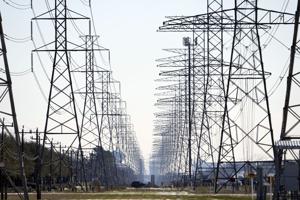Op-Ed: Policymakers must address root causes of Texas fiasco

Whenever public crises or disasters arise, policymakers naturally ask themselves two questions, “What went wrong and what lessons can we learn?” In the case of Texas’ energy grid failure amid winter weather, policymakers should be asking those questions right now. Quite a bit went wrong in the Lone Star State. However, the lesson quickly became clear that government mandates, regulations and subsidies exacerbated the situation.
Just blaming wind and solar technologies themselves is a bit shortsighted. Evidence shows that, in the immediate sense, most of the energy failures came from artificially induced shortfalls of coal and natural gas, exacerbated by rigid regulations that hurt frigid Texans. The cold had driven up the demand for natural gas heating for homes such that its capacity was too thin to provide power for the grid. The Electric Reliability Council of Texas (ERCOT), which operates Texas’ grid, should have immediately noticed this and arranged for more generation in the days leading up to the failure.
But even if solar and wind are not to blame in a direct sense (i.e. the frozen wind turbine), government subsidies favoring “green” energy sources along with stringent federal standards played a large role in exacerbating the current crisis. President Joe Biden’s Department of Energy put ERCOT in a nearly impossible position by demanding they remain within green energy standards during the squeeze. Acting Energy Secretary David Huizenga would not waive environmental restrictions to allow Texas to increase output. Forcing ERCOT to throttle power ahead of a deep freeze put many Texans at risk of losing power altogether and dealing with the consequences on their own.
Other environmental mandates contributed to the conditions that led to this Texas-sized energy failure. According to the Texas Public Policy Foundation (TPPF), the state has lost 3,000 megawatts of thermal (gas and coal) capacity in just the last four to five years. Much of this can be attributed to how routinely thermal plants are being undercut by wind and solar. Wind and solar can afford to do so because of the seemingly never-ending stream of subsidies they receive from the federal government. When thermal plants are being forced out of business and winter months roll around where wind and solar hardly operate at full capacity, disaster is surely right around the corner.
This turn of events was hardly unpredictable. In 2017, then-Secretary of Energy – and former Governor of Texas – Rick Perry ordered the Federal Energy Regulatory Commission (FERC) to find ways to avoid letting renewable subsidies crash power grids. The logic, according to Perry, is that renewable energy is highly variable and grids need reliable sources of back-up generation to get power to consumers, especially in disaster situations. Almost four years later, that warning from Perry has become quite prescient.
Some, sadly, are learning the wrong lesson from this crisis. Climate activists and politicians are actually renewing calls for wind and solar subsidies. This ignores the fact that wind and solar tax credits were set to expire as early as 1999 and that these technologies have more than enough at their disposal to compete with traditional players on their own. Pushing for more subsidies will only exacerbate the existing issues that revealed themselves in Texas.
In addition, calls abound for the “stubborn” Texas government to synch up with federal regulatory standards. But surely, there’s a happy medium between Texas embracing electricity isolationism and onerous federal regulation. The Biden administration can and should take the lead to integrate Texas into interstate electric markets while keeping federal regulations flexible and at a minimum.
Again, it is not that wind and solar by themselves are responsible for this crisis. The government policies in place to promote the growth of these technologies at the expense of others created conditions that made developments like those in Texas not only possible, but likely. The market has a clear interest in never letting something like this happen again.
With the thumb of the federal government on the proverbial scale, Texas grid operators and consumers were never given an adequate chance to choose the most efficient path to avoid catastrophe.
Disclaimer: This content is distributed by The Center Square


